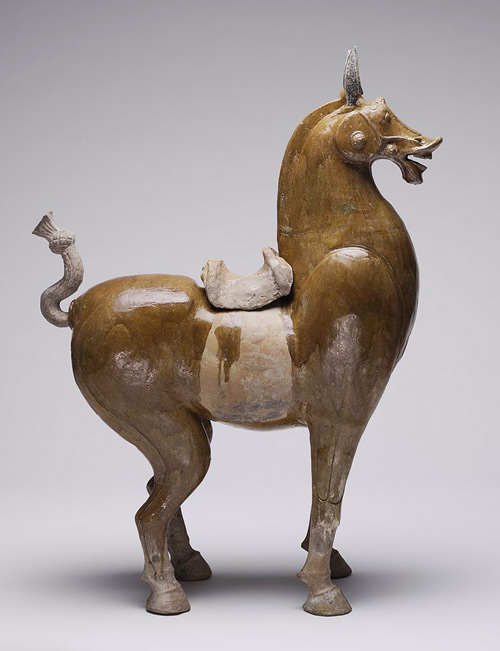2004.211.A-E: Standing Saddled Horse with Clipped Mane, Cropped and Tied Tail, and Roman-Style Bridle Ornaments
SculptureGallery Text
Valued for their strength and endurance, horses symbolized wealth and power in ancient China; in a funerary context, they were believed to transport souls to the next world. Made specifically for burial in a tomb, this sculpture is exceptionally important for several reasons: its large size, brilliant glaze, near-perfect condition, and Romanstyle bridle ornaments. The bridle sports five circular medallions, each with a human face. Their number, placement, and decoration accord exactly with Roman convention and thus provide evidence of early Western influence in China. Horses were especially prized by rulers of the Han dynasty for their military value, as cavalry warfare was used to fend off frequent attacks of nomadic invaders. In the second century BCE, campaigns to procure Central Asian horses led to both the expansion of the Han Empire’s borders and to increased contact between China and the nations to its west along the Silk Road.
Identification and Creation
- Object Number
- 2004.211.A-E
- Title
- Standing Saddled Horse with Clipped Mane, Cropped and Tied Tail, and Roman-Style Bridle Ornaments
- Classification
- Sculpture
- Work Type
- sculpture
- Date
- probably 2nd century
- Places
- Creation Place: East Asia, China, Sichuan province
- Period
- Han dynasty, Eastern Han period, 25-220 CE
- Culture
- Chinese
- Persistent Link
- https://hvrd.art/o/20957
Location
- Location
-
Level 1, Room 1006, East Arcade
View this object's location on our interactive map
Physical Descriptions
- Medium
- Lead-glazed ware: Molded, brick red earthenware with lead-fluxed, caramel brown glaze, the detachable, unglazed tail and saddle molded in brick red earthenware, the detachable, unglazed ears molded in gray earthenware, the unglazed elements displaying traces of cold-painted pigments. Probably from the Chengdu region of Sichuan province.
- Dimensions
- H. 121.5 x L. 90.5 x D. 33 cm (47 13/16 x 35 5/8 x 13 in.)
Provenance
- Recorded Ownership History
-
[R. H. Ellsworth Ltd., New York, 2004] gift; to Harvard University Art Museums, 2004.
Acquisition and Rights
- Credit Line
- Harvard Art Museums/Arthur M. Sackler Museum, Gift of R. H. Ellsworth Ltd. in memory of Phyllis and C. Douglas Dillon
- Accession Year
- 2004
- Object Number
- 2004.211.A-E
- Division
- Asian and Mediterranean Art
- Contact
- am_asianmediterranean@harvard.edu
- Permissions
-
The Harvard Art Museums encourage the use of images found on this website for personal, noncommercial use, including educational and scholarly purposes. To request a higher resolution file of this image, please submit an online request.
Publication History
- Suzanne G. Valenstein, "Preliminary Findings on a 6th-Century Earthenware Jar", Oriental Art, Oriental Art Magazine (Singapore, Winter 1997-1998), vol. XLIII, no. 4, p. 11, figs. 22-23
- Harvard University Art Museums, Harvard University Art Museums Annual Report 2004-2005 (Cambridge, MA, 2005), p. 10
- Suzanne G. Valenstein, Cultural Convergence in the Northern Qi Period: A Flamboyant Chinese Ceramic Container, A Research Monograph, The Metropolitan Museum of Art (New York, 2007), pp. 49, 129, figs. 81-82
Exhibition History
- Re-View: S228-230 Arts of Asia, Harvard Art Museums/Arthur M. Sackler Museum, Cambridge, 05/31/2008 - 06/01/2013
- Re-View: S228-230 (Asian rotation: 6), Harvard Art Museums/Arthur M. Sackler Museum, Cambridge, 05/24/2011 - 11/12/2011
- 32Q: 1600 Early China II, Harvard Art Museums, Cambridge, 11/16/2014 - 03/06/2023
- 32Q: 1006 East Arcade, Harvard Art Museums, Cambridge, 03/06/2023 - 09/15/2025
Subjects and Contexts
- Collection Highlights
- Google Art Project
Related Articles
Verification Level
This record has been reviewed by the curatorial staff but may be incomplete. Our records are frequently revised and enhanced. For more information please contact the Division of Asian and Mediterranean Art at am_asianmediterranean@harvard.edu

